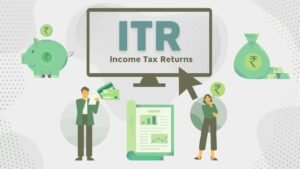How to Save Tax on Fixed Deposits (FD) Fixed deposits have long been considered one of the safest and most reliable investment options in India. Today, millions of people in India save taxes by investing in fixed deposits. Now it’s your turn. Whether you are a salaried professional, a retiree, or a small business owner, chances are you have invested in FD at one time or another, primarily for capital protection and assured returns.
Table of Contents
How to Save Tax on Fixed Deposits?
If you are not sure where to start or need help understanding the complexities of tax laws, consulting a professional can be very helpful. A trusted CA in Kanpur, Vineet Dwivedi, can best guide you about the best options available based on your income, investment goals, and current tax slab, ensuring that you don’t pay a rupee more than necessary.
Understand the tax liability of interest on fixed deposits
Before we dive into the tips and tricks on how to save tax on fixed deposits, it is important to know how interest on FD is taxed. Many people believe that since fixed deposits are safe, the income from them can also be tax-free – but that is not the case.
FD Interest is Taxable Under “Income from Other Sources”
The interest you earn from fixed deposits is not tax-free – it is actually treated as “Income from other sources” when you file your income tax return. This means it is added to your total income for the year and taxed as per your applicable slab rate. So, if you fall in the 30% tax bracket, a large portion of your FD interest could go straight to taxes unless you plan in advance.
Documents Required for Tax Saving FD
- Identity Proof: Aadhaar, PAN, Voter ID, Driving License, Passport, Senior Citizen card, etc.
- Address Proof: Passport, Telephone/Electricity Bill, Bank Statement with Cheque, etc.
TDS (Tax Deducted at Source) on FD Interest
Banks are required to deduct TDS (Tax Deducted at Source) on your FD interest, as the limit is ₹40,000 in a financial year for normal individuals, ₹50,000 in a financial year for senior citizens (above 60 years). If your total FD interest in a year exceeds these limits, the bank will deduct 10% TDS, provided you have submitted your PAN. If you have not submitted PAN card, the TDS rate becomes 20%.
Many people think that once the bank deducts TDS, their tax on FD interest is completely paid, but this is not true. TDS is a part of your total tax. If you fall in a higher tax slab, you may have to pay the remaining amount when you file your income tax return.
When is TDS Deducted?
DS on FD interest is generally deducted at the time the interest is credited, either annually or at the end of the FD tenure, depending on the type of deposit. Even if you don’t withdraw the interest, it is still considered ‘earned’ and becomes taxable in the year it is earned.
Common Misconception: Tax is Only Deducted When You Withdraw
Many investors believe they can avoid tax by not withdrawing FD interest. However, under income tax rules, interest is taxed on a cumulative basis, not on withdrawal. So even if your FD is cumulative (interest paid on maturity), tax is applicable every year as the interest accrues.
How to save tax on fixed deposits: Top 5 ways
Now that you know that the interest on your fixed deposit is taxable, the next question is how can you legally reduce that tax burden? There are many smart ways to save tax while also enjoying the safety and returns of FD. Let us explain those methods in detail one by one.
1. Invest in 5-Year Tax-Saver Fixed Deposits (Section 80C)
One of the simplest ways to get tax benefits from your FD investment is by opting for a 5-year tax-saver fixed deposit. This type of FD qualifies for deduction under Section 80C of the Income Tax Act.
You can claim up to ₹1.5 lakh in deductions in a financial year. However, keep in mind:
- The lock-in period is 5 years, so you can’t withdraw early.
- The interest earned is still taxable; only the principal amount qualifies for deduction.
2. Submit Form 15G or 15H to Avoid TDS
If your total income is below the taxable limit, you can avoid TDS deduction on your FD interest by submitting Form 15G (for individuals below 60 years) or Form 15H (for senior citizens).
But be careful:
- You should only submit these forms if your total income is below the basic exemption limit.
- Submitting these forms without being eligible can lead to penalties.
This is where taking help from a qualified CA in Kanpur can make sure everything is done correctly and legally.
3. Spread Your FD Investments Among Family Members
This is a clever way to reduce tax liability. You can invest in the name of family members who are in a lower or zero tax bracket, like your spouse, parents, or even adult children.
Here’s how it helps:
- The interest will be taxed in their hands, not yours.
- If they don’t have any other income, the tax liability can be zero or very low.
Just remember to plan this carefully to avoid income clubbing rules. A CA in Kanpur can guide you on how to structure this legally and effectively.
4. Take Advantage of Senior Citizen FD
If you’re a senior citizen (60+ years), you have an extra tax benefit available:
- Under Section 80TTB, you can claim a deduction of up to ₹50,000 on interest income earned from fixed deposits.
- Many banks also offer higher interest rates for senior citizen FD.
So if you or your parents are eligible, it’s a good idea to use this option to reduce taxable income from FD.
5. Consider the New Tax Regime – If It Works for You
The new tax regime introduced by the government has lower tax rates, but you will have to give up most deductions and exemptions, including Section 80C.
If you don’t claim too many deductions anyway, the new regime may work better for you. But it depends on your income structure and investments.
A quick tax comparison with the help of a CA in Kanpur can help you decide which regime gives you the best savings, especially if FD interest is a large part of your income.
Mistakes to Avoid While Planning Tax on FD Income
When you invest in a fixed deposit, it’s easy to focus only on the interest you’ll earn and forget about taxes. But if you don’t plan things properly, you may end up paying more tax than you need to or even a penalty. So, before you lock in your FD, let’s take a look at some common mistakes people make when thinking about how to save tax on fixed deposits.
1. Not Submitting Form 15G or 15H (Even When Eligible)
the your income is below the basic tax limit and you forget to submit Form 15G or Form 15H, the bank will deduct TDS from your fixed deposit interest, even if you don’t have to pay any tax.
This small mistake is quite common, especially for senior citizens or people with low incomes. If you are not sure whether you should submit the form or not, it is a good idea to talk to a trusted CA in Kanpur, Uttar Pradesh, who can guide you.
2. Assuming Tax-Saver FDs Are Fully Tax-Free
Many people believe that once they invest money in a 5-year tax-saver FD, they don’t have to worry about any taxes. But this is only partially true. Yes, you get a tax deduction on the amount invested under Section 80C, which is great.
However, the interest you earn on that FD is still taxable – it gets added to your income and is taxed as per your slab. So, don’t make the mistake of thinking that the entire investment is tax-free. It’s better to plan for it now than to be surprised later when you file your returns.
3. Ignoring Clubbing Provisions When Investing in Family Members’ Names
Putting money in your spouse or child’s name to save tax may seem like a smart idea, but there’s a catch. Many people forget about the clubbing rule in the Income Tax Act. Simply put, if you gift money to your spouse and they invest it in a fixed deposit, the interest earned does not remain tax-free – it actually gets added to your income, and you will have to pay tax on it.
4. Believing That TDS Is the Final Tax Liability
One of the biggest misconceptions is that the TDS deducted by the bank is the final tax you have to pay. This is not true. TDS is usually just 10%, but if you are in the 20% or 30% tax bracket, you will have to pay the difference when you file your income tax return.
If you don’t plan for it, you may end up with a huge tax bill at the end of the year – and perhaps even have to pay interest and a penalty for the shortfall in advance tax payment.
5. Forgetting to Report FD Interest in ITR
Some people think they can skip reporting FD interest if the bank has already deducted TDS. This is a risky mistake. You’re required to report all interest income, even if TDS has already been deducted.
Failing to do this could invite notices from the Income Tax Department—and no one wants that kind of trouble.
6. Keeping All FD in a Single Bank to Avoid Hassle
It may be convenient to keep all your fixed deposits in one place, but doing this can cause your total interest income to exceed the TDS threshold, leading to automatic deductions.
Splitting your FDs across multiple banks or branches can help you stay below the limit and give you more control over tax planning.
How a CA Can Help You Save Tax on FD
Not everyone has the time to read up on tax laws, compare options or figure out which one works best. If you’re still unsure about how to save tax on fixed deposits, This is where contacting a qualified CA in Kanpur is extremely important.
A good CA can look at your entire financial picture, help you avoid common mistakes, and ensure you don’t miss any opportunities to save.
Consult for Tha on how to save tax on fixed deposits
Fixed deposits are a popular investment option for a reason: they are safe, reliable, and offer guaranteed returns. But while your money grows quietly in the bank, there is one thing that often gets overlooked: tax on the interest earned. Without proper planning, a large portion of your earnings from FD can go to tax.













